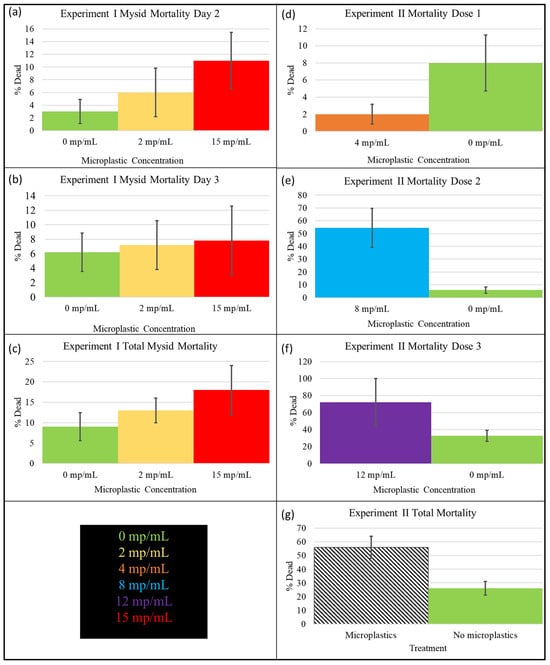Journal Description
Microplastics
Microplastics
is an international, peer-reviewed, open access journal on the science and technology of primary and secondary microplastics published quarterly online by MDPI.
- Open Access— free for readers, with article processing charges (APC) paid by authors or their institutions.
- Rapid Publication: manuscripts are peer-reviewed and a first decision is provided to authors approximately 27.4 days after submission; acceptance to publication is undertaken in 3.7 days (median values for papers published in this journal in the second half of 2023).
- Recognition of Reviewers: APC discount vouchers, optional signed peer review and reviewer names are published annually in the journal.
Latest Articles
Short-Term Microplastics Exposure to the Common Mysid Shrimp, Americamysis bahia: Effects on Mortality and DNA Methylation
Microplastics 2024, 3(2), 234-249; https://doi.org/10.3390/microplastics3020014 - 08 Apr 2024
Abstract
►
Show Figures
Primary consumers of microplastics are often zooplankton species such as the mysid shrimp, Americamysis bahia. Ingesting and interacting with these plastics can cause stress and lead to death. In the presence of some environmental stressors, gene expression may be altered without changing
[...] Read more.
Primary consumers of microplastics are often zooplankton species such as the mysid shrimp, Americamysis bahia. Ingesting and interacting with these plastics can cause stress and lead to death. In the presence of some environmental stressors, gene expression may be altered without changing DNA sequences via the epigenetic methylation of the DNA. Mysid shrimp were exposed to 5-micrometer fluorescent polystyrene microbeads at different concentrations and different lengths of time. No significant effects were observed on mortality within 72 h, but mortality increased significantly thereafter. Microplastics were consumed by mysids and adhered to the mysid carapace and appendages. An ELISA-like (Enzyme-Linked Imuunosorbent Assay) colorimetric assay was employed to assess mysid DNA for differences in global percent methylation. No significant difference in the average percent methylated DNA nor difference in the number of methylation detections between treatments was found. This is one of few studies that has investigated DNA methylation effects due to microplastics-induced stress and the first study to detect DNA methylation in any member of the order Mysida.
Full article
Open AccessReview
Recent Progress in Intestinal Toxicity of Microplastics and Nanoplastics: Systematic Review of Preclinical Evidence
by
Madjid Djouina, Suzie Loison and Mathilde Body-Malapel
Microplastics 2024, 3(2), 217-233; https://doi.org/10.3390/microplastics3020013 - 08 Apr 2024
Abstract
►▼
Show Figures
The tremendous plastic production and poor post-use management are current and future sources of environmental and human contamination due to their degradation products: microplastics and nanoplastics (MNPLs). Methodological developments have allowed MNPLs to be detected in an increasing variety of human foods, as
[...] Read more.
The tremendous plastic production and poor post-use management are current and future sources of environmental and human contamination due to their degradation products: microplastics and nanoplastics (MNPLs). Methodological developments have allowed MNPLs to be detected in an increasing variety of human foods, as well as in stool and colonic mucosa. It was suggested early that the direct contact between MNPLs and intestinal tissues could represent a potential risk for human health. In order to assess this, over the last 3 years, numerous studies have evaluated the impact of MNPL ingestion on intestinal homeostasis in rodents. This comprehensive review reports the preclinical studies published between January 2021 and January 2024, and analyzes their contributions as well as their shortcomings. It shows that evidence is accumulating of the intestinal toxicity of spherical MNPLs, which lead to pro-inflammatory, pro-oxidative, barrier-disruptive and dysbiotic effects. However, the available literature has addressed only a minor part of the potential health issues of MNPLs. Many parameters contributing to MNPL toxicity need to be better taken into account in future studies. Particular attention should be paid to improve the representativeness of MNPLs, as well as to better consider the susceptibility factors of MNPL toxicity, generated especially by an underlying pathology or pathological imprinting.
Full article
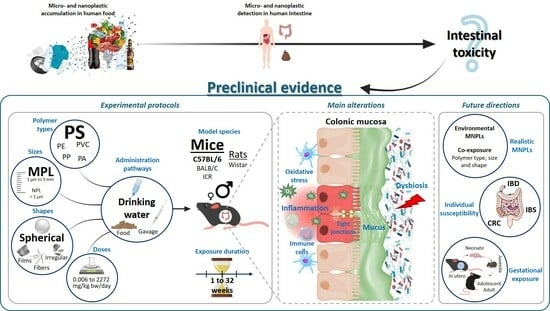
Graphical abstract
Open AccessArticle
Uptake and Cellular Effects of Polymethylmethacrylate on Human Cell Lines
by
Arthur Braun and Harald Seitz
Microplastics 2024, 3(2), 205-216; https://doi.org/10.3390/microplastics3020012 - 05 Apr 2024
Abstract
The usage of plastic and its decomposition products leads to their ubiquitous distribution, resulting in their uptake by all living beings, including humans. Polymethylmethacrylate (PMMA) is known as a biocompatible polymer and is used widely in medicine and dentistry, although recent findings have
[...] Read more.
The usage of plastic and its decomposition products leads to their ubiquitous distribution, resulting in their uptake by all living beings, including humans. Polymethylmethacrylate (PMMA) is known as a biocompatible polymer and is used widely in medicine and dentistry, although recent findings have shown its induction of oxidative stress within cells. Worryingly, hardly any data exist investigating the uptake of PMMA particles by cells, the potential effects of these particles on cells and cell signaling pathways and their contributing factors. We assessed the uptake of PMMA beads via confocal microscopy after their incubation with HEK293, A549 and MRC5 cells. Through cell staining, we localized multiple PMMA beads within the cytosol of cells. No alterations regarding cell growth, cell morphology or cell division were found, implying no short-term toxicity towards human cells. Using a cAMP response element binding protein (CREB)-mediated reporter assay, we assessed whether internalized PMMA nanobeads alter cell signaling pathways after stimulation of the cells. CREB was chosen as a well-described transcription factor involved in various cellular processes. Our data led to the assumption that PMMA nano- and microbeads are internalized via endocytosis and end up in lysosomes within the cell cytosol. We concluded that differences regarding the surface composition of the PMMA nanobeads affect their potential to alter cell signaling. These findings emphasize the key role the surface composition plays regarding microplastics and their risks for human health, whereas the usage of medical-grade PMMA remains safe.
Full article
(This article belongs to the Collection Current Opinion in Microplastics)
►▼
Show Figures
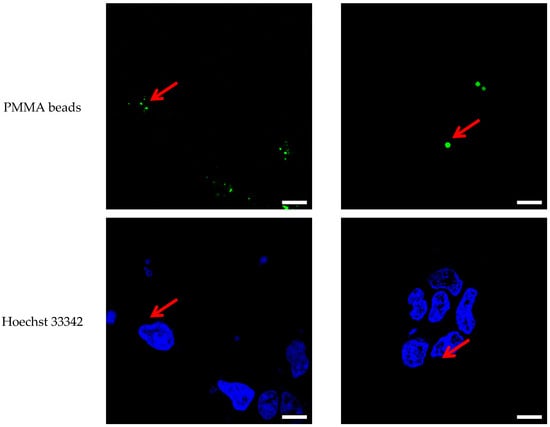
Figure 1
Open AccessArticle
Comparison of Methodologies for Microplastic Isolation through Multicriteria Analysis (AHP)
by
Valentina Phinikettou, Iliana Papamichael, Irene Voukkali and Antonis A. Zorpas
Microplastics 2024, 3(1), 184-204; https://doi.org/10.3390/microplastics3010011 - 10 Mar 2024
Abstract
Environmental pollution caused by microplastics has evolved into a global concern; however, limited knowledge exists about microplastics in soils due to the absence of standardized extraction methods. This research aimed to develop an inexpensive, rapid method with user-friendly and environmentally sustainable outcomes for
[...] Read more.
Environmental pollution caused by microplastics has evolved into a global concern; however, limited knowledge exists about microplastics in soils due to the absence of standardized extraction methods. This research aimed to develop an inexpensive, rapid method with user-friendly and environmentally sustainable outcomes for microplastics retrieval. Three salt solutions (Sodium Chloride, Magnesium Sulfate, Sodium Hexametaphosphate) and an oil solution (canola oil) underwent evaluation for microplastics extraction through the flotation process due to the density and oleophilic properties of plastics. Four widely used plastic types, obtained through fragmentation using a grinding mill from clean new plastic containers or membranes, were subjected to analysis. The experimental procedures for microplastics retrieval varied among the evaluated solutions. Through a comprehensive multicriteria analysis, the saturated Sodium Chloride solution emerged as the optimal scenario for microplastics extraction, followed closely by the canola oil scenario. The recovery method utilizing Sodium Chloride demonstrated economic feasibility, safety, and reliability. This study provides valuable insights into an effective and sustainable approach for mitigating microplastic pollution in soil, offering a promising avenue for future environmental conservation efforts.
Full article
(This article belongs to the Topic Microplastics Pollution)
►▼
Show Figures
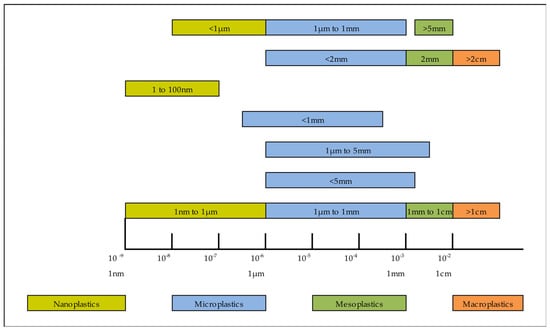
Figure 1
Open AccessArticle
Crafting a Scientific Framework to Mitigate Microplastic Impact on Ecosystems
by
Mitra Nikpay and Sayna Toorchi Roodsari
Microplastics 2024, 3(1), 165-183; https://doi.org/10.3390/microplastics3010010 - 04 Mar 2024
Abstract
►▼
Show Figures
Microplastics (MPs), microscopic particles originating from plastic products, have emerged as a persistent environmental challenge, posing threats to both ecosystems and human health. Their omnipresence, extending from the highest mountains to the deepest oceans and infiltrating the bodies of humans and animals, requires
[...] Read more.
Microplastics (MPs), microscopic particles originating from plastic products, have emerged as a persistent environmental challenge, posing threats to both ecosystems and human health. Their omnipresence, extending from the highest mountains to the deepest oceans and infiltrating the bodies of humans and animals, requires urgent attention. In the face of escalating annual plastic production and inefficient waste management, where 79% of plastic production ends up in landfill sites or enters the environment, MPs multiply as its consequence. This emphasizes the urgent need for a comprehensive global framework that transcends borders to systematically address and control the growth of MPs. In response, our research conducts an in-depth investigation and proposes a seven-step strategy, providing a global perspective for mitigating microplastic pollution. The proposed approach begins with initial research steps and closes in predicting the remediation of areas impacted by microplastic pollution.
Full article
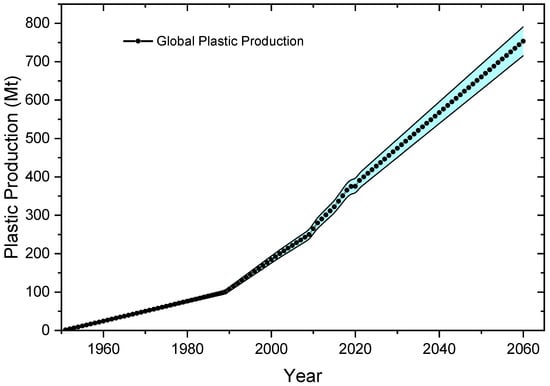
Figure 1
Open AccessArticle
Microplastics in Atlantic Ribbed Mussels (Geukensia demissa) from the Delaware Inland Bays, USA
by
Jeffrey Ashley, Amanda Pilat, Ariana Ohlweiler, Connor Ogden, Owen Bradley, Priya Modi, Spencer Talbot, Caya Smith, Justin O’Pella and Gulnihal Ozbay
Microplastics 2024, 3(1), 147-164; https://doi.org/10.3390/microplastics3010009 - 01 Mar 2024
Abstract
Due to the prevalence of plastic pollution in coastal ecosystems, aquatic organisms are at high risk for accumulating microplastics (MPs). Filter-feeding bivalves, such as mussels and oysters, may be exposed to, and subsequently accumulate, MPs due to the high volume of water they
[...] Read more.
Due to the prevalence of plastic pollution in coastal ecosystems, aquatic organisms are at high risk for accumulating microplastics (MPs). Filter-feeding bivalves, such as mussels and oysters, may be exposed to, and subsequently accumulate, MPs due to the high volume of water they pass through their bodies. This study assessed the levels of MPs within Atlantic ribbed mussels (Geukensia demissa), a common filter feeder found along the United States Atlantic Coast, from 12 sites within Rehoboth Bay, Indian River Bay, and Little Assawoman Bay, collectively known as the Delaware Inland Bays. Composited mussels from each site were digested using potassium hydroxide and filtered. Microplastics were physically identified, sorted based on color, and counted using a digital microscope. Microplastics, almost entirely dominated by synthetic microfibers, were found in all mussels well above laboratory blanks. Across all sites, 40% of microfibers were black, and 27% of fibers were clear. The composite concentrations of MPs ranged from 0.25 to 2.06 particles/g wet tissue, with a mean of 0.08 ± 0.06. In general, higher concentrations were found in mussels collected at sites that were adjacent to more urbanized land use versus those from rural sites. At two sites, individual mussels, in addition to composites, were analyzed and had MP concentrations ranging from 11 to 69 particles/mussel. This study represents the first evaluation of MPs in this ecologically important coastal species and suggests its viability as a biomonitoring species for microplastic pollution.
Full article
(This article belongs to the Special Issue Microplastics in Aquatic Enviroments)
►▼
Show Figures
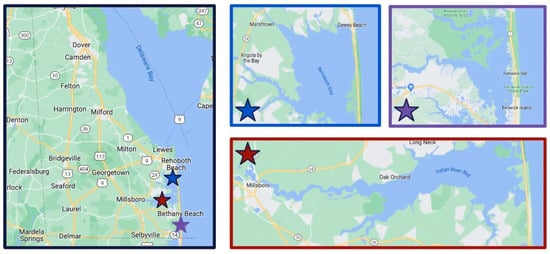
Figure 1
Open AccessArticle
An Image-Processing Tool for Size and Shape Analysis of Manufactured Irregular Polyethylene Microparticles
by
Melanie Fritz, Lukas F. Deutsch, Karunia Putra Wijaya, Thomas Götz and Christian B. Fischer
Microplastics 2024, 3(1), 124-146; https://doi.org/10.3390/microplastics3010008 - 09 Feb 2024
Abstract
Microplastics (MPs) pose a significant risk to humans and animals due to their ability to absorb, adsorb, and desorb organic pollutants. MPs catchment from either sediments or water bodies is crucial for risk assessment, but fast and effective particle quantification of irregularly shaped
[...] Read more.
Microplastics (MPs) pose a significant risk to humans and animals due to their ability to absorb, adsorb, and desorb organic pollutants. MPs catchment from either sediments or water bodies is crucial for risk assessment, but fast and effective particle quantification of irregularly shaped particles is only marginally addressed. Many studies used microscopy methods to count MP particles, which are tedious for large sample sizes. Alternatively, this work presents an algorithm developed in the free software GNU Octave to analyze microscope images of MP particles with variable sizes and shapes. The algorithm can detect and distinguish different particles, compensate for uneven illumination and low image contrast, find high-contrast areas, unify edge regions, and fill the remaining pixels of stacked particles. The fully automatic algorithm calculates shape parameters such as convexity, solidity, reciprocal aspect ratio, rectangularity, and the Feret major axis ratio and generates the particle size distribution. The study tested low-density polyethylene particles with sizes of 50–100 µm and 200–300 µm. A scanning electron microscope image series analyzed with Octave was compared to a manual evaluation using ImageJ. Although the fully automatic algorithm did not identify all particles, the comprehensive tests demonstrate a qualitatively accurate particle size and shape monitoring applicable to any MPs, which processes larger data sets in a short time and is compatible with MATLAB-based codes.
Full article
(This article belongs to the Collection Current Opinion in Microplastics)
►▼
Show Figures
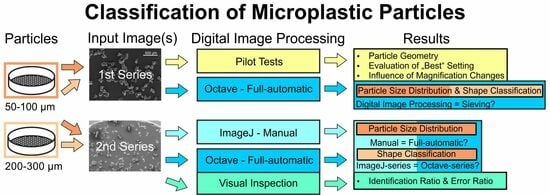
Graphical abstract
Open AccessReview
Advancements and Regulatory Situation in Microplastics Removal from Wastewater and Drinking Water: A Comprehensive Review
by
Vyoma Jani, Shenghua Wu and Kaushik Venkiteshwaran
Microplastics 2024, 3(1), 98-123; https://doi.org/10.3390/microplastics3010007 - 08 Feb 2024
Abstract
In recent years, the ubiquitous occurrence of plastic debris has become a significant environmental concern, posing considerable harm to our ecosystems. Microplastics (MPs) (1 μm–5 mm) and nanoplastics (NPs) (<1 μm) are noticeable in diverse forms, spreading throughout the environment. Notably, wastewater treatment
[...] Read more.
In recent years, the ubiquitous occurrence of plastic debris has become a significant environmental concern, posing considerable harm to our ecosystems. Microplastics (MPs) (1 μm–5 mm) and nanoplastics (NPs) (<1 μm) are noticeable in diverse forms, spreading throughout the environment. Notably, wastewater treatment plants (WWTPs) emerge as major contributors to the generation of MP and NP. Within these treatment plants, water influx from domestic and commercial sources carries a considerable load of MPs derived from items like fiber clothing, personal care products, and toothpaste. Lacking dedicated removal mechanisms, these MPs persist through the wastewater treatment process, ultimately entering natural water bodies and the soil environment. The novelty of this review lies in its detailed examination of contemporary methodologies for sampling, detecting, and eliminating MPs specifically from WWTPs. By critically assessing the efficacy of current removal techniques at various treatment stages, the review offers targeted insights into practical aspects of MP management in these facilities. As the study of micro/nano plastics is still in its early stages, this article aims to contribute by offering a comprehensive review of the methods utilized for plastic debris removal in both WWTPs and drinking water treatment plants (DWTPs). Furthermore, the article provides a comprehensive overview of the existing rules, regulations, and policies concerning MPs in the United States. This inclusion not only broadens the scope of the review but also establishes it as a valuable reference for understanding the regulatory framework related to MPs. This review uniquely combines a focused evaluation of WWTPs/DWTPs, an exploration of removal methods, and an examination of regulatory framework, making a different contribution to the review article. Through this review, we aim to enhance understanding and awareness of the multi-layered challenges posed by MPs, offering insights that can inform future research directions and policy initiatives.
Full article
(This article belongs to the Collection Current Opinion in Microplastics)
►▼
Show Figures
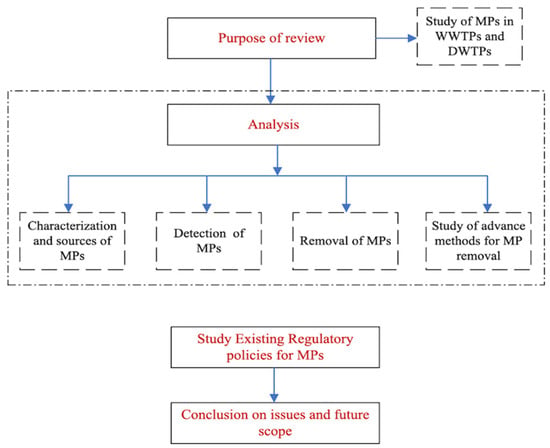
Figure 1
Open AccessReview
Micro- and Nanoplastics in the Atmosphere: Methodology for Microplastics Size-Fractionation Sampling
by
Yuliya Logvina, Isabel M. Matas, Helena Ribeiro, Luís Pinto da Silva, Pedro Rodrigues, João Leitão and Joaquim Esteves da Silva
Microplastics 2024, 3(1), 82-97; https://doi.org/10.3390/microplastics3010006 - 08 Feb 2024
Abstract
Micro- and nanoplastics (MNPs) are an important atmospheric aerosol constituent. However, there still needs to be a standard procedure for their sampling and size fractionation, which is an obstacle to the aggregation and critical analysis of results obtained by different research groups. This
[...] Read more.
Micro- and nanoplastics (MNPs) are an important atmospheric aerosol constituent. However, there still needs to be a standard procedure for their sampling and size fractionation, which is an obstacle to the aggregation and critical analysis of results obtained by different research groups. This review focuses on the sampling and fractionation methodologies used for MNPs. Moreover, a streamlined, simplified methodology for sampling and fractionation is proposed.
Full article
(This article belongs to the Collection Current Opinion in Microplastics)
►▼
Show Figures
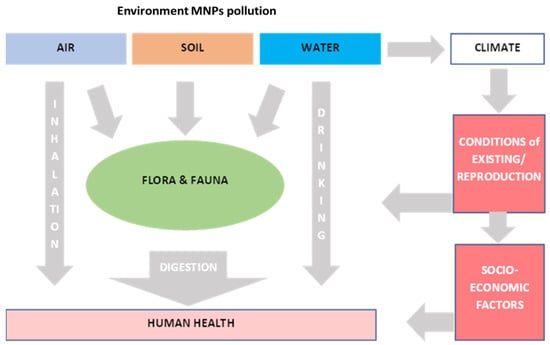
Figure 1
Open AccessArticle
A Feasible and Efficient Monitoring Method of Synthetic Fibers Released during Textile Washing
by
Oskar Świątek and Agnieszka Dąbrowska
Microplastics 2024, 3(1), 67-81; https://doi.org/10.3390/microplastics3010005 - 30 Jan 2024
Abstract
Microfibers (MFs) are one of the most common and hazardous forms of microplastic found in the aquatic environment. The methods of collecting and analyzing MFs released during washing have to be developed and standardized to understand and model the process of microfibers’ emission
[...] Read more.
Microfibers (MFs) are one of the most common and hazardous forms of microplastic found in the aquatic environment. The methods of collecting and analyzing MFs released during washing have to be developed and standardized to understand and model the process of microfibers’ emission better. This study tests a new, innovative method to check if laundry fiber sampling can be approached comprehensively. Pieces of synthetic materials (aged and new polyester, polyester-cotton blend) were placed in chromium-nickel filters envelope-like folded. Then, textile weathering during washing was monitored by the quality and quantity of fibers found directly on the filter surface. Laundry parameters like temperature, detergent presence, and filter size were changed, and results were monitored by Fourier-transform infrared spectroscopy (FTIR), a well-known standard in microplastic identification. In addition, ATR spectra were collected to characterize the materials in detail and evaluate their aging level. Spectroscopy can be used to detect and examine both mechanical and chemical degradation, and the collected microfibers can be assigned to the material they come from. Finally, a quantitative comparison of fibers released during different washing conditions can be used for the process optimization to minimize its environmental impact.
Full article
(This article belongs to the Collection Current Opinion in Microplastics)
►▼
Show Figures
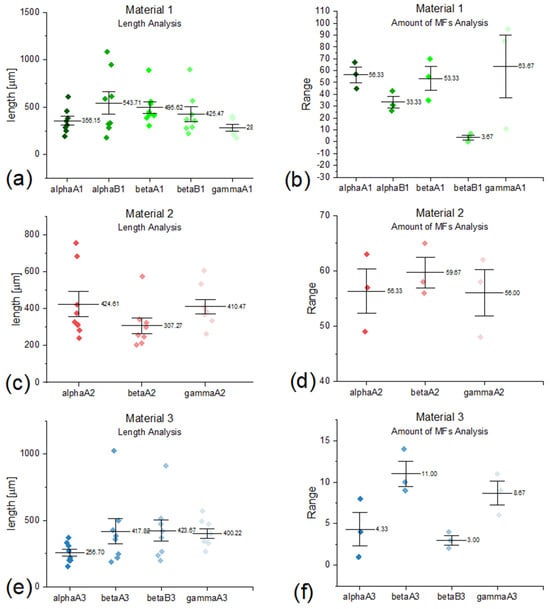
Figure 1
Open AccessReview
Bridging the Gaps between Microplastics and Human Health
by
Stephanie Damaj, Farah Trad, Dennis Goevert and Jeff Wilkesmann
Microplastics 2024, 3(1), 46-66; https://doi.org/10.3390/microplastics3010004 - 11 Jan 2024
Abstract
►▼
Show Figures
Given the broad and intense use of plastic, society is being increasingly affected by its degradation and by-products, particularly by microplastics (MPs), fragments smaller than 5 mm in size, and nanoplastics (NPs), with sizes less than 1 µm. MPs and NPs may enter
[...] Read more.
Given the broad and intense use of plastic, society is being increasingly affected by its degradation and by-products, particularly by microplastics (MPs), fragments smaller than 5 mm in size, and nanoplastics (NPs), with sizes less than 1 µm. MPs and NPs may enter the body primarily through inhalation, consumption, and skin contact. Once ingested, MPs can penetrate tissues, deviating to other parts of the body and potentially affecting important cellular pathways such as nonconforming chemokine receptors that control the communication between the fetus and the mother. Consequently, the potential health harm induced via MP internalization is a major issue, evidenced by multiple studies demonstrating harmful consequences in diverse animal models and human cells. Here, an overview of the various modes of exposure to MPs and NPs is presented, including inhalation, placental transfer, ingestion, breastmilk consumption, and skin absorption, as well as placental and fetal toxicity due to plastic particles based on animal and in vitro studies. Though MPs in our environment are becoming more recognized, their developmental toxicity is still scarcely known. Besides negatively affecting pregnancy, MPs and NPs have been shown to potentially harm the developing fetus, given their ability to cross the placental barrier. Still, considerable gaps remain in our understanding of the dispersion and toxicity of these particles in the environment and the precise types of NPs and MPs bearing the greatest dangers. As a result, we advocate for larger-scale epidemiological investigations, the development of novel approaches for measuring NP and MP exposures, and the necessity of understanding the toxicity of various kinds of NPs to guide future research efforts.
Full article
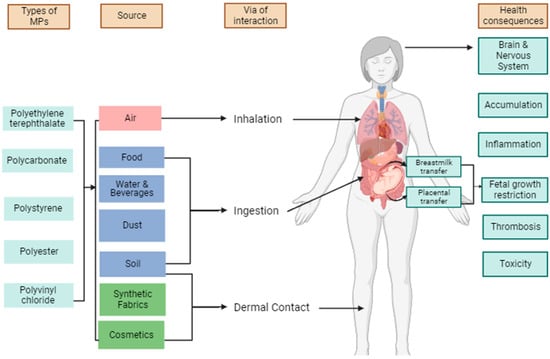
Figure 1
Open AccessArticle
Microplastic in Drinking Water: A Pilot Study
by
Eleonora Brancaleone, Daniela Mattei, Valentina Fuscoletti, Luca Lucentini, Gabriele Favero, Giancarlo Cecchini, Alessandro Frugis, Valentina Gioia and Marco Lazzazzara
Microplastics 2024, 3(1), 31-45; https://doi.org/10.3390/microplastics3010003 - 09 Jan 2024
Abstract
►▼
Show Figures
In recent years, microplastic pollution has been a hot topic as these compounds have been used in various production contexts such as health, food or technology due to their chemical and physical properties and “shelf-life,” making them almost indispensable products in daily life.
[...] Read more.
In recent years, microplastic pollution has been a hot topic as these compounds have been used in various production contexts such as health, food or technology due to their chemical and physical properties and “shelf-life,” making them almost indispensable products in daily life. On the other hand, they have a negative impact on the environment and, consequently, on biota and human health. It is therefore necessary to assess the actual presence of microplastics in drinking water by analysing real samples in order to estimate the possible exposure through drinking water consumption. In this pilot study, drinking water from different aqueous matrices was examined for the presence of microplastics and characterized in terms of shape, size, abundance and polymer type by Raman microspectroscopy analysis. Not all samples analysed were found to be contaminated with microplastics, indeed, some, as in the case of water kiosk samples, were found to be free of such contaminants. The results for the various matrices showed that the microplastics content ranged from less than 2 particles/L to a maximum of 5 + 1.5 particles/L, with sizes ranging from 30 to 100 μm and consisted of the most common polymers such as polyethylene, polypropylene or polyethylene terephthalate.
Full article
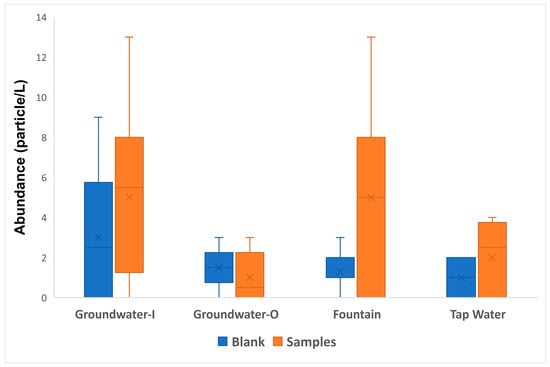
Figure 1
Open AccessCommunication
The Standard and Reverse Mode Operation of a Hydrocyclone for Microplastic Separation
by
Thomas Senfter, Andreas Walter, Lukas Dür, Florian Alber, Manuel Berger, Michael Kraxner and Martin Pillei
Microplastics 2024, 3(1), 22-30; https://doi.org/10.3390/microplastics3010002 - 09 Jan 2024
Abstract
►▼
Show Figures
Harmonization in the analytical framework is needed to detect, define and further categorize plastics released into the environment. In the range of particles smaller than 200 μm, hydrocyclones (HCs) have proven their capacity in removing microplastics efficiently by offering technical advantages at low
[...] Read more.
Harmonization in the analytical framework is needed to detect, define and further categorize plastics released into the environment. In the range of particles smaller than 200 μm, hydrocyclones (HCs) have proven their capacity in removing microplastics efficiently by offering technical advantages at low operational costs. This publication aims to expand scientific knowledge by introducing four commercially available, low-priced microplastics to a pilot-scale HC setting. The physicochemical characteristics of particles as well as the separation efficiency of the test rig were investigated in depth. Particles with a density of >1000 kg/m3 passed the primary vortex and were discharged into the underflow, allowing us to employ standard mode operation. Particles with a density of <1000 kg/m3 entered the secondary vortex and were removed through the overflow. As expected, separation efficiencies were found to be higher for particles revealing a greater density difference when compared with the mobile phase water. Furthermore, an increase in the inlet volume flow revealed significant positive impacts on the separation efficiency for three plastics to a certain threshold. Data on standard and reverse mode operations presented in this publication can lay out an important source for the harmonization and standardization of future HC research, with the goal of overcoming plastic pollution by developing economically competitive separation processes.
Full article
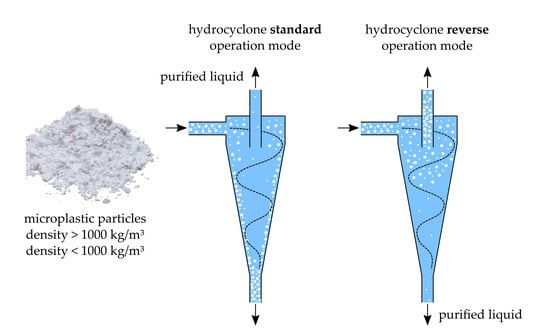
Graphical abstract
Open AccessReview
Comparative Review of Instrumental Techniques and Methods for the Analysis of Microplastics in Agricultural Matrices
by
Adeola Adelugba and Chijioke Emenike
Microplastics 2024, 3(1), 1-21; https://doi.org/10.3390/microplastics3010001 - 20 Dec 2023
Abstract
►▼
Show Figures
Microplastics (MPs) are ubiquitous and evasive in nature. They can be found in complex agricultural matrices like soil and compost. In the literature, extracting MPs from soil is more prevalent; nonetheless, the same instruments in extraction in soil samples can also be used
[...] Read more.
Microplastics (MPs) are ubiquitous and evasive in nature. They can be found in complex agricultural matrices like soil and compost. In the literature, extracting MPs from soil is more prevalent; nonetheless, the same instruments in extraction in soil samples can also be used to assess MPs in compost despite the high levels of organic material. MPs in agricultural environments have recently become a focus of research due to their status as emerging pollutants. However, the lack of standardized instruments and techniques for analysis is a major challenge in assessing MPs. Despite this limitation, this review article identified and suggested some important factors to consider when selecting suitable methods or instruments for MP analysis. This article also categorized instrumental analysis in MP studies as destructive and non-destructive and highlighted the advantages and disadvantages of methods and instruments such as visual inspection, Fourier transform infrared (FTIR) spectroscopy, Raman spectroscopy (RS), and Scanning Electron Microscope (SEM). These highlights will provide researchers with a useful guide to help them choose the most appropriate method and instrumentation technique for their MP analytical research. Additionally, the article discusses the combination of two or more of these analytical instruments to improve efficiency.
Full article
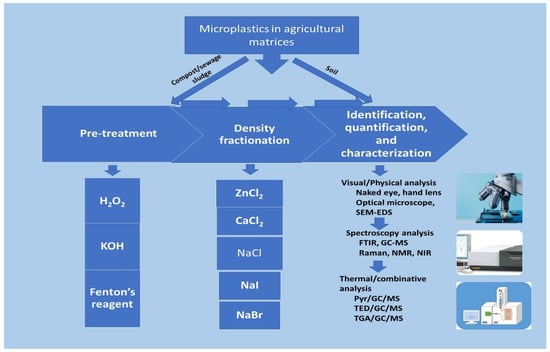
Figure 1
Open AccessArticle
Presence of Microplastics in the Vaquita Marina Protection Zone in Baja California, Mexico
by
Arely Areanely Cruz-Salas, Juan Carlos Alvarez-Zeferino, Jocelyn Tapia-Fuentes, Sheila Liliana Dafne Lobato-Rocha, Alethia Vázquez-Morillas, Sara Ojeda-Benítez and Samantha E. Cruz-Sotelo
Microplastics 2023, 2(4), 422-436; https://doi.org/10.3390/microplastics2040031 - 16 Dec 2023
Abstract
►▼
Show Figures
Microplastics (MP) have been evidenced in marine and coastal areas worldwide, including the Gulf of California in Mexico, where the Vaquita Marina refuge area is located, which in turn borders the protected natural area Alto Golfo de California y Delta del Rio Colorado.
[...] Read more.
Microplastics (MP) have been evidenced in marine and coastal areas worldwide, including the Gulf of California in Mexico, where the Vaquita Marina refuge area is located, which in turn borders the protected natural area Alto Golfo de California y Delta del Rio Colorado. This research aimed to determine the concentrations of microplastics in the Vaquita protection zone, analyzing samples of ten transects of surface water and samples in the sand of five beaches on the coast surrounding the Vaquita protection polygon. The total concentrations of MP in the surface water transects were from 0.000 to 0.020 MP/m3 and their most recurrent characteristics were fragments (69.0%), the chemical composition of polyethylene (60.0%), the blue color (39.0%) and a size of 2.1–3.0 mm (31.0%). While for the beaches, these corresponded to averages ranging from 28.2 ± 36.4; 17.6 to 200.7 ± 77.9; 193.7 MP/m2, the most common characteristics of MP from beaches were filaments (33.2%), PE (32.3%), white (28.0%), and a size of 4.1–5.0 mm (32.0%). The results suggest that part of the MP on the beaches and in the Vaquita Marina refuge area could come from urban areas such as the Gulf of California and activities such as fishing. It is recommended to study all the transects of the Vaquita Marina polygon and more beaches surrounding it in different seasons to better understand the status of MP pollution.
Full article
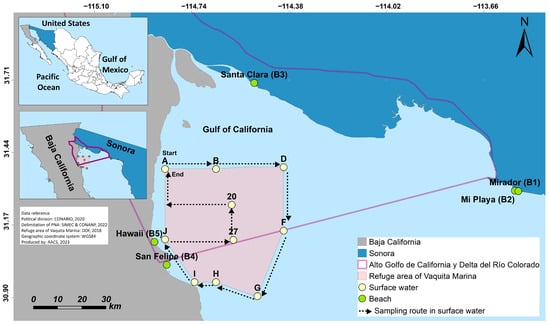
Figure 1
Open AccessArticle
Abundance and Characteristics of Fibrous Microplastics and Microfibers Isolated in Mullus barbatus from the Adriatic Sea—Preliminary Investigation
by
Serena Santonicola, Michela Volgare, Mariacristina Cocca and Giampaolo Colavita
Microplastics 2023, 2(4), 411-421; https://doi.org/10.3390/microplastics2040030 - 14 Dec 2023
Abstract
Despite the wide distribution of textile microfibers in the marine environment, there is still limited knowledge on microfiber ingestion in fish species intended for human consumption, mostly due to analytical issues. The present study aims to assess the occurrence of microfibers in red
[...] Read more.
Despite the wide distribution of textile microfibers in the marine environment, there is still limited knowledge on microfiber ingestion in fish species intended for human consumption, mostly due to analytical issues. The present study aims to assess the occurrence of microfibers in red mullet (Mullus barbatus) samples collected from the Italian waters of the central Adriatic Sea. M. barbatus is a bottom fish that lives in contact with sediment and therefore was proposed as a sentinel species for the monitoring plastic pollution. A visual approach based on the evaluation of specific microfiber surface morphology was applied for the identification of particles of different origins. The preliminary findings showed the presence of microfibers in 80% of red mullet samples with a mean of 5.95 microfibers/individual. The majority (>80%) of the isolated microfibers were of natural/artificial origin, while the dominant colors were blue and black. The obtained results confirmed that benthic fish species are susceptible to microfiber ingestion and indicate the high availability of these particles in the Adriatic basin. Considering the spectroscopic drawbacks in microfiber analyses and the need to improve the current knowledge on the rate of contamination of fishery products, the visual approach could be a feasible, easy, and accessible method in the study of microfiber pollution, and the assessment of consumer health risks.
Full article
(This article belongs to the Special Issue Monitoring, Detection and Mitigation of Micro and Nanoplastics)
►▼
Show Figures
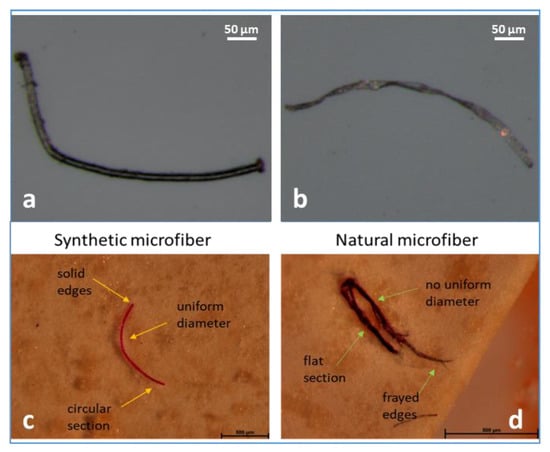
Figure 1
Open AccessReview
Progress in Research on the Bioavailability and Toxicity of Nanoplastics to Freshwater Plankton
by
Vera I. Slaveykova and Matea Marelja
Microplastics 2023, 2(4), 389-410; https://doi.org/10.3390/microplastics2040029 - 28 Nov 2023
Abstract
►▼
Show Figures
The present review critically examines the advancements in the past 5 years regarding research on the bioavailability and toxicity of the nanoplastics (NPLs) to freshwater plankton. We discuss the recent progress in the understanding of adsorption, absorption, trophic transfer, and biological effects in
[...] Read more.
The present review critically examines the advancements in the past 5 years regarding research on the bioavailability and toxicity of the nanoplastics (NPLs) to freshwater plankton. We discuss the recent progress in the understanding of adsorption, absorption, trophic transfer, and biological effects in phyto- and zooplankton induced by NPLs exposure. The influence of plankton on NPLs’ bioavailability via the excretion of biomolecules and formation of eco-corona is also examined. Despite important research developments, there are still considerable knowledge gaps with respect to NPLs’ bioavailability and trophic transfer by plankton as well as a potential adverse effect in natural aquatic systems. As plankton play a critical role in primary production, nutrient cycling, and food web structure, understanding the interactions between NPLs and plankton is essential in assessing the potential implications of NPLs pollution for aquatic ecosystem biodiversity and services.
Full article

Figure 1
Open AccessReview
The Impact of Microplastics on Global Food Production: A Brief Overview of This Complex Sector
by
Thúlio Righeti Corrêa, Christine C. Gaylarde, José Antônio Baptista Neto, Jéssica de F. Delgado, Leonardo da S. Lima, Danieli L. Cunha and Estefan M. da Fonseca
Microplastics 2023, 2(4), 371-388; https://doi.org/10.3390/microplastics2040028 - 15 Nov 2023
Abstract
Environmental pollution management combined with food safety represents two of the main challenges of the last decades. Soil and water contamination has historically threatened food safety. As ubiquitous pollutants, microplastics (MPs) have attracted increasing attention over the last few years. These particles can
[...] Read more.
Environmental pollution management combined with food safety represents two of the main challenges of the last decades. Soil and water contamination has historically threatened food safety. As ubiquitous pollutants, microplastics (MPs) have attracted increasing attention over the last few years. These particles can affect the balance of terrestrial, aquatic, and aerial ecosystems. Their negative impacts are intensified when they adsorb and carry toxic chemicals. They can circulate through organisms and accumulate in human beings via food and water. Physiological dysfunctions in all species continue to be reported, both in terrestrial and aquatic ecosystems. This article considers how this might be affecting the global production of food. It reports the adverse effects induced by MPs in soils, their properties and organisms growing within and upon them, including livestock and the pollinating agents necessary for plant growth. A separate section discusses the effects of MPs on aquaculture, mentioning effects on wild species, as well as farmed fish. The growing concern of the food production sector with MPs mimics that of the world with global warming; the danger is real and requires urgent attention.
Full article
(This article belongs to the Special Issue Monitoring, Detection and Mitigation of Micro and Nanoplastics)
►▼
Show Figures
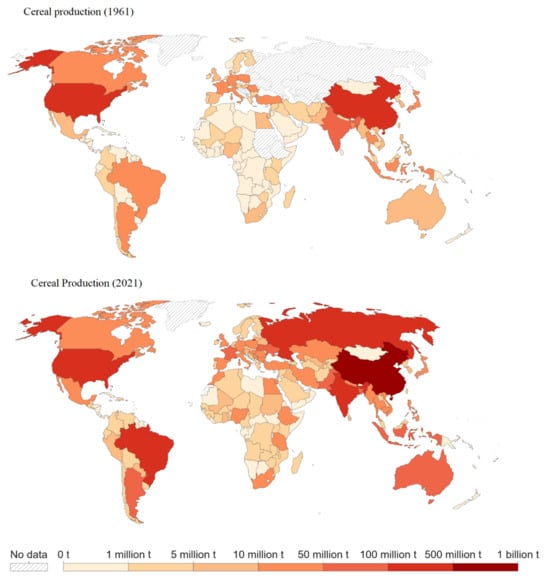
Figure 1
Open AccessArticle
Experimental Validation of the Microplastic Index—Two Approaches to Understanding Microplastic Formation
by
Kalouda Grigoriadi, Merel G. A. Nooijens, Ali Emre Taşlı, Max M. C. Vanhouttem, Sieger Henke, Luke A. Parker, Jan Harm Urbanus and Arjen Boersma
Microplastics 2023, 2(4), 350-370; https://doi.org/10.3390/microplastics2040027 - 03 Nov 2023
Abstract
The Microplastic Index (MPI) was presented in a previous paper as a method to assess the formation of microplastics during the application of impact and wear stresses, based on selected mechanical and physical properties of polymers. In this paper, the experimental validation of
[...] Read more.
The Microplastic Index (MPI) was presented in a previous paper as a method to assess the formation of microplastics during the application of impact and wear stresses, based on selected mechanical and physical properties of polymers. In this paper, the experimental validation of the MPI model is presented. A series of ten polymers was characterized to obtain the relevant parameters for the calculation of the MPI, i.e., the minimum particle size and volume of microplastics formed. The milling (addressing impact stress) and sanding experiments (addressing wear stress) resulted in particle sizes between 3 and 200 μm and 0.3 and 25 μm, respectively. These values were very well predicted by the MPI model, showing smaller particles for brittle polymers and larger ones for ductile polymers. In addition, the experimental-specific wear rates of impact and wear correlated well with the predicted ones, being 0.01–30 mm3/Nm for impact and 0.0002–0.012 mm3/Nm for wear. These results indicate that the MPI can be very well used to predict the tendency of a material to form microplastics. In the search for understanding and mitigating microplastic formation, the MPI can be used by both producers and end users to choose plastic grades that form fewer microplastics.
Full article
(This article belongs to the Collection Current Opinion in Microplastics)
►▼
Show Figures
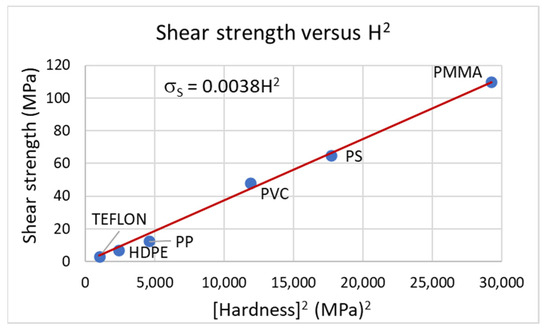
Figure 1
Open AccessArticle
Fast Forward: Optimized Sample Preparation and Fluorescent Staining for Microplastic Detection
by
Michael Toni Sturm, Erika Myers, Anika Korzin, Sabrina Polierer, Dennis Schober and Katrin Schuhen
Microplastics 2023, 2(4), 334-349; https://doi.org/10.3390/microplastics2040026 - 22 Oct 2023
Cited by 1
Abstract
The fast, affordable, and standardized detection of microplastics (MP) remains one of the biggest challenges in MP research. Comparable data are essential for appropriate risk assessments and the implementation of laws and limit values. The fluorescent staining of MP in environmental samples is
[...] Read more.
The fast, affordable, and standardized detection of microplastics (MP) remains one of the biggest challenges in MP research. Comparable data are essential for appropriate risk assessments and the implementation of laws and limit values. The fluorescent staining of MP in environmental samples is a possible solution to this problem. This study investigates the optimization of a sample preparation process (hydrogen peroxide digestion) and the staining process (temperature, concentration, time, surfactants as staining aids) for using a specifically developed fluorescent dye for MP detection. The optimization is performed by comparing the sample preparation process and staining of MP from different polymers and natural particles. Further, the suitability of the optimized process for the detection of fluoropolymers and tire abrasion was tested. The results show that the optimized method (increased temperature and optimized stain concentration) can detect microplastics reliably with a total sample preparation and measurement time of 2.5–3 h per sample, reaching recovery rates of 93.3% (polypropylene) to 101.7% (polyester). Moreover, two of the three tested fluoropolymers could be detected reliably. Tire abrasion could not be detected with the here presented method, as the black color leads to strong quenching. A long-term study measuring the MP pollution in the effluent of a municipal wastewater treatment plant compared the optimized and original processes and confirmed the stability of the improved method for routine measurements and contamination control.
Full article
(This article belongs to the Collection Current Opinion in Microplastics)
►▼
Show Figures

Figure 1
Highly Accessed Articles
Latest Books
E-Mail Alert
News
Topics
Topic in
IJERPH, Microplastics, Sustainability, Toxics, Water
Microplastics Pollution
Topic Editors: Grigorios L. Kyriakopoulos, Vassilis J. Inglezakis, Antonis A. Zorpas, María Rocío Rodríguez BarrosoDeadline: 31 August 2024
Topic in
Agrochemicals, Environments, Water, Toxics, Soil Systems, Microplastics, Microorganisms, Sustainability
The Challenges and Future Trends in Anthropogenic and Natural Pollution Control Engineering
Topic Editors: Chenyang Zhang, Fujing Pan, Xiaoyu Gao, Weiqi Fu, Anxu Sheng, Zhiqiang Kong, Lei He, Sining Zhong, Jie ChenDeadline: 31 December 2024
Topic in
Agriculture, Animals, Fermentation, Microplastics, Veterinary Sciences
Livestock and Microplastics
Topic Editors: Sonia Tassone, Beniamino T. Cenci-GogaDeadline: 20 May 2025

Conferences
Special Issues
Special Issue in
Microplastics
Microplastics and Human Health: Impact, Challenges and Interaction Mechanisms
Guest Editor: Javier BayoDeadline: 30 September 2024
Topical Collections
Topical Collection in
Microplastics
Current Opinion in Microplastics
Collection Editor: Nicolas Kalogerakis
